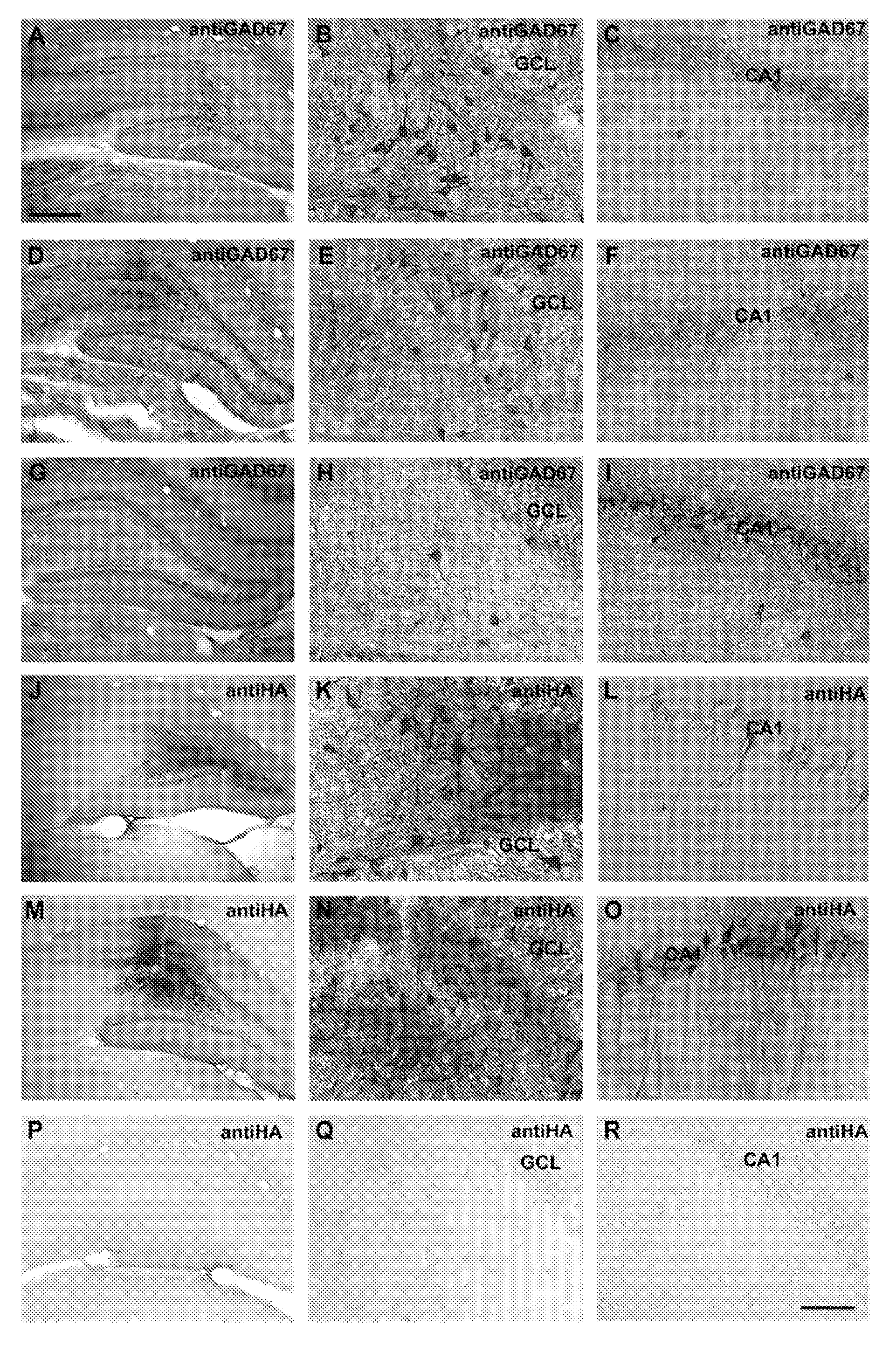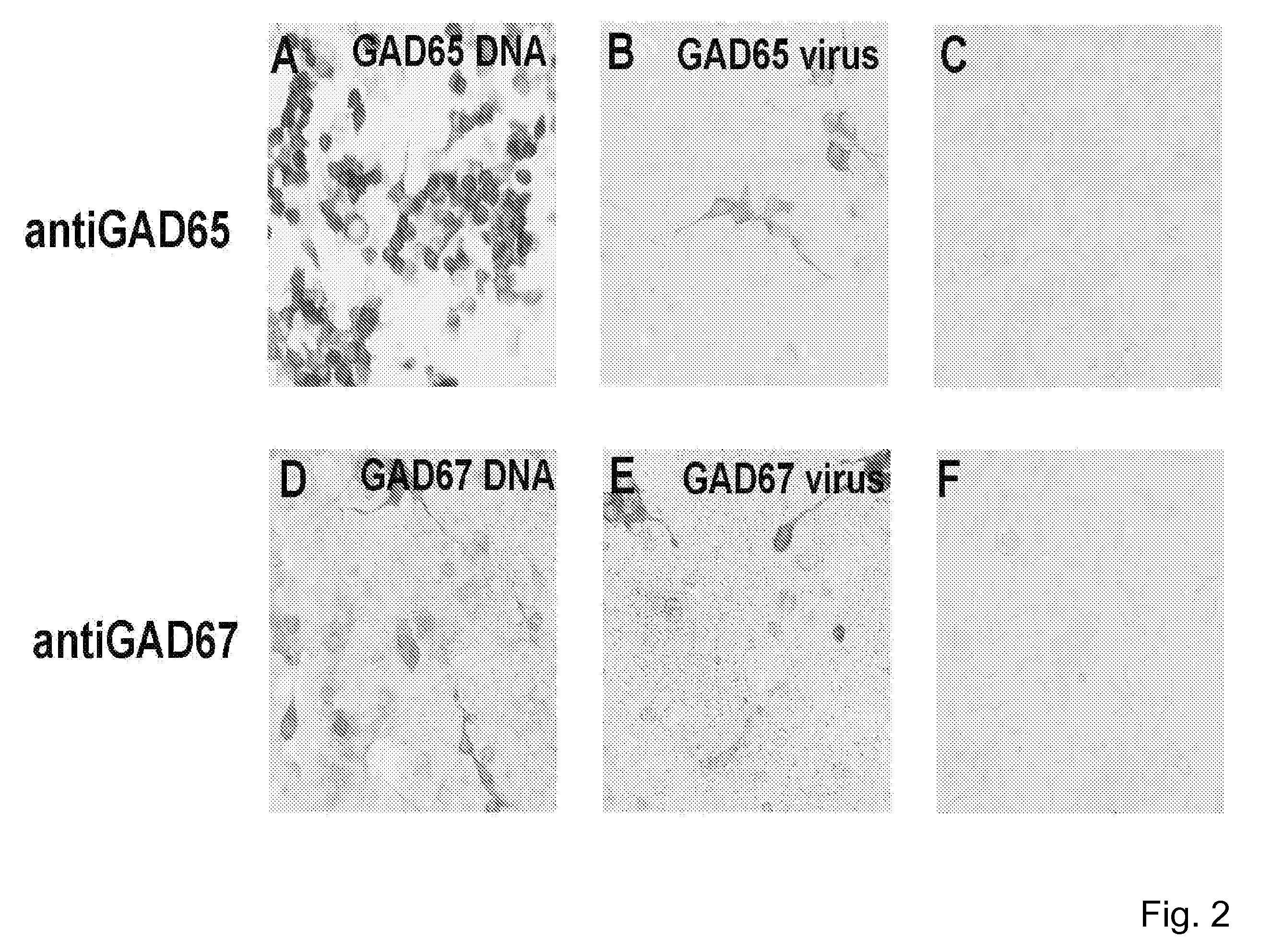Glutamic acid decarboxylase (GAD) based delivery system
a glutamic acid decarboxylase and delivery system technology, applied in the direction of animal repellents, drug compositions, peptide/protein ingredients, etc., can solve the problems of difficult treatment of epilepsy, movement disorders or other neurological deficits and symptoms, and the effect of promoting the improvement of neurodegenerative diseases and reducing the effect of overstimulation
- Summary
- Abstract
- Description
- Claims
- Application Information
AI Technical Summary
Benefits of technology
Problems solved by technology
Method used
Image
Examples
example 1
Methods and Materials
(i) Vector Construction
[0133]This example describes the construction of an adeno-associated virus vector with an GAD cDNA. A full length human GAD-65 cDNA was subcloned into an AAV plasmid under the control of a 1.8 kb rat NSE (neuron specific enolase) promoter (Foress-petter et al. (1986) J. Neurosci. Res. 16, 141-156 (1998)) 5′ of the GAD cDNA followed by the Woodchuck Hepatitis Post-Transcriptional Regulatory Element (WPRE) and a bovine growth hormone (BGH) polyadenylation site between the AAV inverted terminal repeats, as previously described (During et al. (1998) Nature Med. 4:1131-1135). The resulting plasmid is referred to as pAAV-NSE-GAD-WPRE.
[0134]The plasmids were packaged to generate high titer rAAV-GAD viral particles using an optimized protocol based on the original helper-free transient transfection method described by Samulski et al. (1989) J. Virol. 63:3822-3828), but modified by using an improved 4th generation helper plasmid, pDG as described b...
example 2
In Vitro Transduction of the AAVGAD Vectors
[0143]The GAD-65 and GAD-67 vectors were transduced into primary neuronal cultures from the subthalamic nucleus. FIG. 1 shows an image of cells infected with AAV vectors expressing GAD-67 (top two panels) with a MOI of 10 (multiplicity of infection) in transient transfection experiments. The antibodies were detected using a commercially available antibody for Immunocytochemical detection. A similar experiment was conducted using cells infected with AAV vectors expressing GAD-65 with an MOI of 10 (middle two panels), and detected using an antibody specific for GAD-65. This data demonstrates successful transduction of vectors and successful expression of the vectors in-vitro in primary neuronal cultures from the subthalamic nucleus.
example 3
Additional Vector Constructs and Materials
[0144]Other AAV plasmid constructs that can be used include those containing different enhancers and promoters. For example, an AAV plasmid construct for GAD65 with a 1.1 kb Cytomegalovirus Enhancer / Chicken-Actin (CBA) hybrid promoter, 1760 base pair (bp) human GAD65 cDNA (Genbank accession number M81882), 647 bp Woodchuck Hepadnavirus Post Transcriptional Regulatory Element (WPRE), 269 bp Bovine Growth Hormone Polyadenylation sequence (BGH-polyA), flanked by 145 bp AAV Inverted Terminal Repeats (ITRs). This construct is referred to as pAM / CBA-hGAD65-WPRE-BGHpolyA.
[0145]Another AAV plasmid construct for GAD67 is one with a 1.1 kb CBA promoter, 1780 bp human GAD67 cDNA (Genbank accession number M81883), 647 bp WPRE, 269 bp BGH-polyA, flanked by 145 bp AAV ITRs. This construct is referred to as pAM / CBA-hGAD67-WPRE-BGHpolyA.
[0146]The advantages using CBA is demonstrated by Xu et al., have shown that an AAV vector with the CBA promoter resulted ...
PUM
| Property | Measurement | Unit |
|---|---|---|
| density | aaaaa | aaaaa |
| density | aaaaa | aaaaa |
| pH | aaaaa | aaaaa |
Abstract
Description
Claims
Application Information
 Login to View More
Login to View More - R&D
- Intellectual Property
- Life Sciences
- Materials
- Tech Scout
- Unparalleled Data Quality
- Higher Quality Content
- 60% Fewer Hallucinations
Browse by: Latest US Patents, China's latest patents, Technical Efficacy Thesaurus, Application Domain, Technology Topic, Popular Technical Reports.
© 2025 PatSnap. All rights reserved.Legal|Privacy policy|Modern Slavery Act Transparency Statement|Sitemap|About US| Contact US: help@patsnap.com



